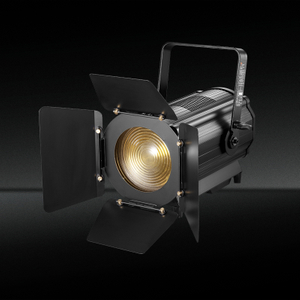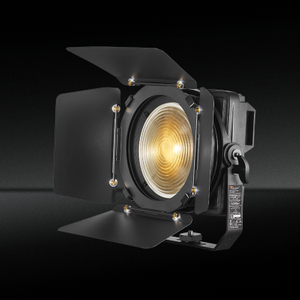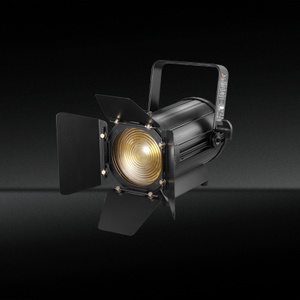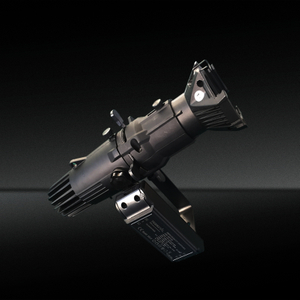What is a follow spot in lighting?
Views: 0 Author: Site Editor Publish Time: 2025-08-27 Origin: Site








Type of Stage Lighting | Usage Percentage (%) |
|---|---|
LED Fixtures | 61 |
Moving Head Lights | 29 |
PAR Lights | 23 |
Strip Lights | 19 |
Follow Spot Lights | 14 |
Follow spots deliver high-intensity light, maintain the main character’s visibility, and help guide the audience’s focus during live events. They stand out for their flexibility and ability to adapt to the demands of theatrical lighting.
Common functions include:
Following performers as they move on stage
Directing audience attention to key actions
Providing focused, high-intensity illumination

Key Takeaways
A follow spot light is a powerful, manually controlled spotlight that tracks moving performers to keep them clearly visible on stage.
Operators adjust the beam’s size, focus, and color in real time, making follow spots essential for dynamic live performances.
Modern follow spots often use energy-efficient LED technology, saving costs and producing less heat while delivering bright light.
Follow spots help guide the audience’s attention by highlighting key actions, emotions, and important moments during shows and events.
Both manual and automated follow spot systems exist, but skilled operators remain vital for precise and responsive performer tracking.
Follow Spot Light Basics

What Is a Follow Spot?
A follow spot is a specialized type of spotlight used in theatrical lighting. It stands out from other lighting instruments because it allows an operator to track and highlight a performer as they move across the stage. The follow spot uses a powerful lamp, such as a xenon arc or LED, to produce a high-intensity, narrow beam. Operators can adjust the beam’s size, focus, and color in real time. This flexibility makes the follow spot essential for live performances where performers move frequently.
Key components that distinguish a follow spot from other stage lights include:
Manual or DMX-controlled operation for tracking performers.
Operator-controlled optical mechanisms, such as mechanical shutters, to quickly douse the light.
Adjustable lenses to control and focus the beam width.
Internal color gels in a color magazine for instant color changes.
Powerful light sources, ranging from incandescent bulbs to modern LEDs.
Dynamic adjustment of beam size, intensity, and color during a show.
Specification Category | Details |
|---|---|
Light Source | 350W LED or Phillips MSD Platinum 15R lamp |
Beam Angle | 6° to 10°, adjustable |
Luminous Output | 10,770 LUX at 10 meters, up to 24,000 lumens |
Effects | Iris, framing, frost, smooth dimming 0-100% |
Control | Manual or DMX, button and fader panel |
Power Consumption | 400-450W, AC 100-240V |
Weight | 9.9 kg to 24 kg |
Accessories | Tripod stand, road case, powerCON cable |
A follow spot light provides more than just illumination. It offers precise beam control and high intensity, which are critical for tracking performers and creating dramatic effects. Some models, like the SuperArc, increase beam intensity by moving the lamp forward as the iris closes. This feature sets them apart from traditional spotlights, which may not offer the same level of control or flexibility.
Note: New technologies, such as RobotSpot, allow remote control of multiple follow spots, but manual operation remains popular for its precision and responsiveness.
Purpose on Stage
The main purpose of a follow spot light is to keep performers visible and in focus during live events. Operators use these lights to direct a concentrated beam onto specific individuals or objects, ensuring the audience’s attention stays where it matters most. Theatrical lighting designers rely on follow spots for several reasons:
They produce a high-intensity, narrow beam that can be aimed precisely at performers or props.
They highlight key actions and emotions, helping the audience follow the story.
They track performers’ movements, keeping them illuminated as they move across the stage.
They create dramatic effects by emphasizing important moments with focused lighting.
They can illuminate specific objects or areas, such as set pieces or props.
Skilled operators adjust position, intensity, and color in real time, enhancing the visual and emotional impact.
They help audiences follow the show, especially in productions with lip-syncing or complex choreography.
Follow spot lights play a vital role in live performances. They ensure that lead actors, soloists, or important props remain visible, even in large venues or complex stage setups. The manual control allows for quick adjustments, making them ideal for dynamic performances. Compared to static or automated spotlights, follow spots offer unmatched flexibility and focus, making them a staple in theatrical lighting design.
Spot Fixture Type | Key Feature | Movement | Primary Application |
|---|---|---|---|
Profile/Ellipsoidal | Precise beam shaping, static gobos | Static | Fixed, precise illumination |
Spot Moving Head | Automated pan/tilt, gobos, zoom, color control | Automated | Dynamic, moving highlights |
Follow Spot | High power, manual iris and focus, smooth control | Manual | Tracking performers dynamically |
A follow spot light enhances visibility and focus on stage, outperforming many other lighting options. It allows the audience to connect with the performance by always keeping the main action in the spotlight.
How It Works
Manual Operation
A follow spot light often relies on skilled operators for manual control. These operators stand behind the spotlight, using handles and controls to aim the beam at moving performers. They adjust the focus, size, and color of the light in real time. This hands-on approach allows for quick reactions to unexpected movements on stage.
Operators must develop several important skills to use a follow spot effectively in professional settings:
Knowledge of lighting equipment and techniques
Manual dexterity and strong hand-eye coordination
Ability to follow instructions and work as part of a team
Attention to detail for precise tracking
Physical fitness to handle equipment and work in challenging positions
Adaptability to meet creative demands from directors and artists
Ability to assemble and de-rig lighting and electronic equipment
Effective communication during live shows
Commitment to safety and ergonomic work practices
Safe operation of machines and mobile electrical systems under supervision
These skills help operators keep performers in the spotlight, maintain safety, and support the overall success of a theatrical lighting setup. Operators often work from elevated platforms or catwalks, which requires confidence and awareness of their surroundings. They must also respond quickly to cues from the stage manager or lighting designer.
Tip: Good communication between the follow spot operator and the production team ensures smooth transitions and accurate performer tracking during live events.
Automated Options
Advancements in technology have introduced automated options for follow spot lights. These systems use cameras, sensors, and software to track performers on stage without constant manual input. Automated follow spot systems like Follow-Me and BlackTrax use remote tracking technology. They gather camera feeds and positioning data to keep the spotlight on the performer, even as they move unpredictably.
Modern systems such as Follow-Me 3D and Track-iT offer flexible and scalable tracking. They can control any pan-tilt lighting fixture, not just traditional follow spots. These systems allow multiple fixtures to follow one performer or several performers at once. Track-iT uses RF tags worn by performers and antennas placed around the stage. This setup provides accurate positioning and reliable tracking, even in complex environments.
Software improvements have made automated follow spot lights more precise. Features like enhanced aiming modes and dynamic proximity control adjust the light based on the performer’s position. These advancements have been used in major concerts for artists like Ed Sheeran and The Rolling Stones, showing their impact on modern lighting design.
AI-driven tracking systems use computer vision and artificial intelligence to keep the spotlight on moving performers. These systems reduce the workload for operators. One person can manage several spotlights at once, or sometimes no operator is needed at all. The technology adapts instantly if a performer moves off their expected path, ensuring continuous illumination.
Automated follow spot systems integrate with lighting consoles, video, sound, and automation systems. They share real-time data to synchronize lighting effects with the performers’ movements. This integration creates a seamless experience for both the audience and the production team.
Note: Automated follow spot lights do not replace manual operation entirely. Many productions use a mix of manual and automated systems to achieve the best results.
Features
Throw Distances
Follow spot lights come in different types based on their throw distances. Throw distance means how far the spotlight can shine while keeping the performer bright and clear. Theatrical lighting designers choose the right follow spot for each venue by considering these ranges:
Short throw: 5 to 20 feet. These follow spots work best in small theaters or close-up stage settings.
Medium throw: 25 to 55 feet. Medium throw follow spots, like the Astro 250 HP, cover most mid-sized venues.
Long throw: 55 to 120 feet or more. Models such as the Astro 600 can reach across large theaters, arenas, or outdoor stages.
Different types of follow spot lights use various lamp technologies. LED follow spot lights provide long throw distances with high efficiency, making them ideal for concerts and large events. Xenon and carbon arc spotlights deliver intense brightness for very long throws, while halogen spotlights suit moderate distances with warm color tones. The right throw distance ensures the follow spot light stands out against other stage lighting and keeps the performer visible in any venue.
LED and Energy Efficiency
Modern follow spot lights often use LED technology. LEDs save at least 75% more energy than traditional incandescent bulbs. They also last much longer, which means less maintenance and lower costs. For example, running an LED spotlight for 25,000 hours costs about $30, while an incandescent spotlight costs around $169 for the same time. Theatrical lighting teams choose LED follow spots to reduce electricity bills and support eco-friendly productions. In large venues, switching to LED spotlights can cut annual energy costs by up to 95%. LED follow spot lights also produce less heat, making them safer and more comfortable for operators.
Accessories
Follow spot lights use many accessories to improve performance and flexibility on stage. Common accessories include:
Gel frames and color filters: Change the color of the spotlight beam.
Irises: Adjust the beam size for precise focus on the performer.
Tripod stands and bases: Provide stable mounting and easy movement.
Color scrollers: Allow remote color changes during a show.
Barndoors, snoots, and top hats: Shape and control the light beam.
Safety cables and clamps: Ensure secure installation.
Moving mirror attachments: Enable remote repositioning of the beam.
These accessories help theatrical lighting designers create dynamic effects and adapt the follow spot light to any stage setup. The right combination of accessories ensures the spotlight remains a key tool in every live performance.
Uses

Theater and Musicals
Theater productions and musicals rely on follow spot lights to create powerful visual effects. Lighting designers use these tools to highlight lead actors, soloists, or important props. Theatrical lighting teams often choose follow spots because they can adapt to fast-paced scenes and complex choreography.
Spotlights enhance visibility by projecting concentrated light on performers, making actions and expressions easy to see.
They add drama and emphasis by creating shadows and highlighting emotions, enriching the immersive experience.
Follow spots help the audience focus on key actions, even in crowded or busy scenes.
Lighting teams adjust color and intensity to set the mood, from romantic to suspenseful.
Spotlights create depth and dimension by manipulating light position, making the stage look larger or more dramatic.
A follow spot light allows operators to track performers as they move, ensuring the audience never loses sight of the main action. This flexibility makes follow spots essential in theatrical lighting design.
Concerts and Events
Concerts and live events use follow spot lights to keep performers in the spotlight, no matter how much they move. Technicians manually operate these lights, following singers, musicians, or speakers across the stage. This approach ensures the audience always sees the main performer clearly, even in large venues.
High-brightness follow spots provide superior visibility and dramatic emphasis, especially in arenas or outdoor concerts.
Spotlights with high color rendering index (CRI) deliver natural color appearance, which is important for fashion shows and detailed productions.
Lighting teams use follow spots to highlight solo acts, lead singers, or emotional moments, creating a cinematic effect.
Follow spot lights help shape the mood of the event and maintain a strong visual connection between the audience and the performers.
Presentations
Presentations, especially in corporate or formal settings, benefit from the precise illumination that follow spot lights provide. These lights focus directly on the speaker, making sure the audience can see and engage with the presenter.
Lighting Type | Benefits for Presentations |
|---|---|
Spot Lighting | Focused, consistent illumination; simple setup; reliable performance; energy-efficient; precise tracking |
Moving Head Lighting | Dynamic effects; requires more technical skill; higher power consumption |
Follow spots highlight key speakers or moments without distracting from screens or other elements.
Proper positioning avoids glare and keeps the speaker comfortable.
Spotlights work with ambient lighting to balance visibility and maintain a professional look.
A follow spot light ensures the presenter stands out, helping the audience stay focused and engaged throughout the event.
Comparison
Follow Spot vs. Other Spotlights
A follow spot light stands apart from other spotlights in theatrical lighting. The main difference comes from its ability to track and highlight moving performers during live events. Operators use follow spots to keep the beam focused on a subject, even as they move across the stage. Other spotlights, such as PAR cans, Fresnels, or ellipsoidals, provide broader and more static illumination. These lights usually stay fixed and do not follow performers.
Feature/Aspect | Follow Spot Lights | Other Spotlights (PAR cans, Fresnels, Ellipsoidals) |
|---|---|---|
Purpose | Track and highlight moving subjects dynamically during performances | Provide broader, static or less focused illumination |
Operation | Manually operated for precise tracking | Generally static or less interactive |
Beam Control | Adjustable beam angles, iris adjustments, blackouts | Less adjustable beam control |
Brightness | High brightness to cut through ambient light | Varies, generally less intense for tracking |
Bulb Type | Often use high intensity discharge (HID) bulbs | Use incandescent, halogen, or LED bulbs |
Control Options | Advanced controls including DMX512 compatibility, automated options | Limited or no advanced automation |
Accessories | Gobos, color filters, iris, blackouts (dousers), dampers | Fewer or no such accessories |
Throw Distance | Designed for specific throw distances based on venue size | Not specifically designed for long throw distances |
Functional Difference | Ability to dynamically track and illuminate specific subjects | Provide static or less focused illumination |
Follow spot lights offer advanced features. Operators can adjust beam angles, use iris controls, and create blackouts instantly. These lights often include accessories like gobos and color filters, which add creative effects to a performance. Other spotlights in theatrical lighting usually lack these dynamic controls and accessories.
A follow spot light uses high-intensity bulbs and advanced control systems. This design ensures the beam remains bright and focused, even in large venues with strong ambient lighting.
Cost and maintenance also differ. Follow spot lights cost more than standard spotlights. Prices range from $1,500 to over $13,000, depending on the model and technology. Maintenance for traditional follow spots includes replacing ignitors, ballasts, and internal parts. Skilled technicians must perform yearly servicing. LED follow spots reduce some maintenance needs but still require investment. Other spotlights, such as LED or halogen fixtures, have lower initial costs and simpler upkeep.
A follow spot light remains the best choice for dynamic tracking and focused illumination in live performances. Other spotlights serve well for general stage lighting but cannot match the flexibility and control of a follow spot.
A Follow Spot Light remains essential in Theatrical Lighting for its versatility and impact. Event planners choose Follow Spot and Spotlight options for several reasons:
LED Follow Spot Lights deliver up to 130 lumens per watt, offering powerful illumination with less energy.
Operators gain precise control over color temperature and beam angle, enhancing every performance.
Long lifespan and energy savings reduce costs, with some venues seeing a 75% drop in energy use.
Understanding these features helps any team create memorable, professional events.
FAQ
What makes a Follow Spot Light different from a regular Spotlight?
A Follow Spot Light allows an operator to track a performer’s movement on stage. Regular spotlights stay fixed and cannot follow action. The Follow Spot Light provides more control and flexibility in Theatrical Lighting, making it essential for live performances.
Can a Follow Spot Light use LED technology?
Yes, many modern Follow Spot Lights use LED technology. LED Follow Spot Lights save energy, last longer, and produce less heat. Theatrical Lighting designers often choose LED options for their efficiency and bright, focused beams.
Where do theaters usually place a Follow Spot Light?
Theaters often place a Follow Spot Light at the back of the auditorium or on a balcony. This position gives the operator a clear view of the stage. The Follow Spot can then track performers easily during any show.
Is a Follow Spot Light hard to operate?
Operating a Follow Spot Light requires practice and skill. Operators must track performers smoothly and adjust the beam quickly. Training helps operators master the controls and become an important part of the Theatrical Lighting team.
Why do concerts use Follow Spot Lights?
Concerts use Follow Spot Lights to keep singers and musicians visible at all times. The Follow Spot Light highlights key moments and directs the audience’s attention. This Spotlight creates a dramatic effect and enhances every live event.





